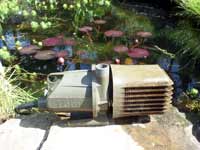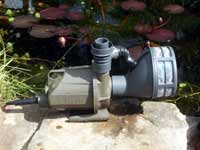
Protect your tadpoles - with a Rotorflush pond pump filter!
Many owners of natural wildlife ponds will have no need of a pond pump. Mine runs a small cascade which provides additional interest, the relaxing sound of a running stream and helps to oxygenate the pond. The stream is regularly used by birds for bathing and drinking, particularly during the cold winter months when running water is hard to find.
When I cleaned the pump's inbuilt filter I found that it was clogged with the remains of scores of tadpoles that had somehow managed to squeeze through the narrow plastic mesh on the Lotus pump. Although the mesh only looks small (click the left hand picture for a better view) it was obviously big enough to accommodate even quite large tadpoles.
 |
 |
In an attempt to prevent a recurrence I have replaced the original filter housing with a Rotorflush filter - picture on the right. This has an ultra fine gauze mesh, too small for even the smallest of tadpoles to find a way in, and a rotating impeller inside the housing. The impeller is driven by diverting some of the pump's outlet water via a narrow corrugated tube - (click the picture to see more clearly). The rotating impeller pushes debris away from the pump and minimizes cleaning. The fine gauze filter is easily removed if necessary and can be swilled in water in seconds to remove any tiny silt particles:- much easier than cleaning a traditional filter. A recent inspection showed the interior of the filter housing to be tadpole free, so it has achieved its primary objective. When the tadpoles are small they can still be sucked towards the gauze so you could consider site visitor George Pledger's DIY technique. See below.
"My present pump, new last year and another Hozelock doesn't have a sponge, and the holes in the casing are supposedly too small to trap pond occupants. Sadly this is just not true. First trapped creature was a newt whose tail got sucked down the very narrow gap round the outlet pipe and the casing. I thought this was just a one off fluke, but another newt had its foot sucked into one of the small holes in the casing. Normally this just wouldn't happen, but it dawned on me that the suction from the pump (Hozelock Cascade 1500) was pulling the creature’s feet or tail through the small holes. The problem is that the casing round the pump is too small and there is not a large enough gap between the holes in the casing and the pump intake. I bought two lily baskets (even smaller holes than the pump casing) and wired them together with the pump inside them. So there is a large open space between the casing and the pump so the effect of the suction is reduced and there is no sign of creatures getting trapped."
The Rotorflush has adaptors to enable it to fit a variety of pumps, but check the literature or their website first. The only downside to date is that there is now less water available to power the cascade, even with the adjuster on its lowest setting. If you intend to purchase a pond pump and a Rotorflush filter at the same time, it might be worth getting a pond pump with more power, to compensate for this.
![]() |
Frogs, frogspawn & tadpoles - page [
1 ] [ 2 ] | | Wildlife
pond building - main page |
|
Frogs, frogspawn & tadpoles - page [
1 ] [ 2 ] | | Wildlife
pond building - main page |